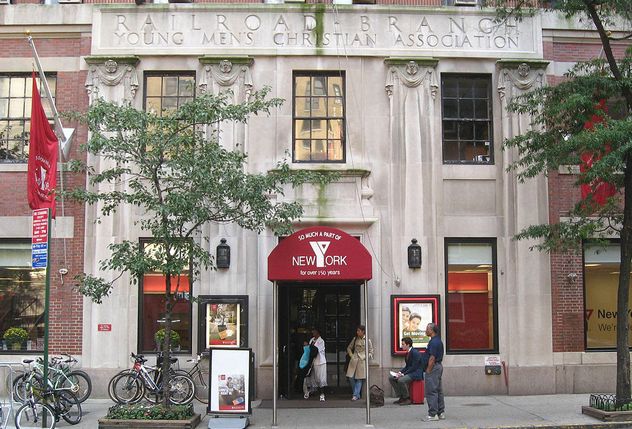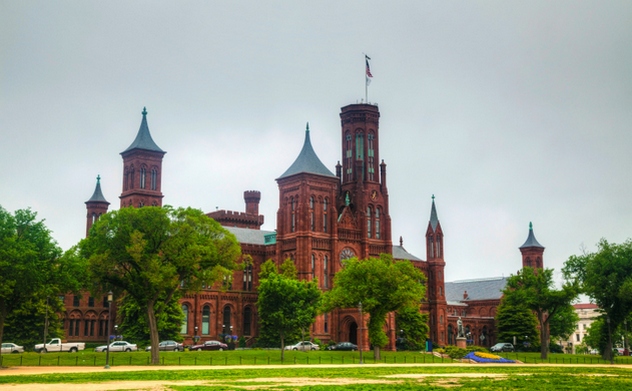 Weird Stuff
Weird Stuff  Weird Stuff
Weird Stuff  Our World
Our World 10 Ways Your Christmas Tree Is More Lit Than You Think
 Movies and TV
Movies and TV The 10 Coolest Stars to Set Sail on The Love Boat
 History
History 10 Things You Didn’t Know About the American National Anthem
 Technology
Technology Top 10 Everyday Tech Buzzwords That Hide a Darker Past
 Humans
Humans 10 Everyday Human Behaviors That Are Actually Survival Instincts
 Animals
Animals 10 Animals That Humiliated and Harmed Historical Leaders
 History
History 10 Most Influential Protests in Modern History
 Creepy
Creepy 10 More Representations of Death from Myth, Legend, and Folktale
 Technology
Technology 10 Scientific Breakthroughs of 2025 That’ll Change Everything
 Weird Stuff
Weird Stuff Ten Bizarre Facts About The Doge Meme
 Our World
Our World 10 Ways Your Christmas Tree Is More Lit Than You Think
 Movies and TV
Movies and TV The 10 Coolest Stars to Set Sail on The Love Boat
Who's Behind Listverse?

Jamie Frater
Head Editor
Jamie founded Listverse due to an insatiable desire to share fascinating, obscure, and bizarre facts. He has been a guest speaker on numerous national radio and television stations and is a five time published author.
More About Us History
History 10 Things You Didn’t Know About the American National Anthem
 Technology
Technology Top 10 Everyday Tech Buzzwords That Hide a Darker Past
 Humans
Humans 10 Everyday Human Behaviors That Are Actually Survival Instincts
 Animals
Animals 10 Animals That Humiliated and Harmed Historical Leaders
 History
History 10 Most Influential Protests in Modern History
 Creepy
Creepy 10 More Representations of Death from Myth, Legend, and Folktale
 Technology
Technology 10 Scientific Breakthroughs of 2025 That’ll Change Everything
10 Of The Richest Tax-Exempt Organizations
In 2008, more than 315,000 nonprofit charity organizations reported $1.4 billion in revenue and $2.5 trillion in assets. By 2011, there were 1.6 million nonprofit organizations registered with the IRS. Without any public input, political discussion, or due process, the Internal Revenue Service—sometimes in a seemingly arbitrary fashion—grants some organizations a preferential status in which they are exempt from paying taxes, even though they benefit from the services the collective tax base provides.
The overwhelming majority of these are called 501(c)(3) organizations, after the section of that IRS code that exempts them from taxation. The rules to achieve and maintain 501(c)(3) status—or any of the more than two dozen other 501 sub-statuses—are complicated and convoluted. Generally, these organizations should not exist for the purpose of enriching themselves or their shareholders, they should not be political in nature, and they should be charitable or contribute to social welfare.
SEE ALSO: 10 Refreshing Stories Of Rich People Who Gave Their Fortunes Away
Many, however, are among the wealthiest organizations in the world and engage in far less charitable work than their counterparts in the private sector. When Congress first began carving out exemptions to the then-new corporate tax in the Revenue Act of 1894, it focused on “religious, charitable and educational” entities—and that legacy continues today. The list of the wealthiest tax-exempt organizations in the US is dominated by groups that often operate under the presumption of benevolence: churches, universities, and hospitals.
10. Churches

The Roman Catholic Church is almost certainly the wealthiest organization in the world. In the United States alone, it is estimated that the Catholic Church has an operating budget of $170 billion. By comparison, in fiscal year 2012, Apple and General Motors each had about $150 billion in revenue worldwide. No one outside the Vatican knows for sure how much money the church has, because—unlike every other category of tax-exempt “nonprofit” organizations—religious organizations in the United States are not required to submit basic financial reporting to the IRS. From Vatican City (the Catholic Church’s own country) to St. Patrick’s Cathedral in Manhattan, the Church owns some of the most extraordinary art and architecture the world has ever known. It operates a vast and lucrative network of schools, universities, and hospitals whose Medicare and Medicaid patients are bankrolled by American taxpayers, yet it is listed as a nonprofit organization.
Although it is by far the largest and richest of the bunch, the Catholic Church is hardly alone. All organizations that fit into the IRS’s loose and subjective definition of a “church” are automatically exempt from paying federal taxes, paying taxes on their investments, and reporting their finances. Churches are not even required to apply for federal tax-exempt status, unlike the Red Cross and every other nonprofit, which endure rigorous and repeated IRS scrutiny. As a bonus, every single state and the District of Columbia exempt churches from paying state income taxes and property taxes, meaning that taxpayers subsidize the police protection, fire protection, and other local services they receive.
Ministers and other clergy may write off their rent, mortgage, home upkeep, furniture, utilities—even their cable bills. Churches cumulatively spend just a tiny fraction of their fortunes on actual charity. The multibillion-dollar Church of Jesus Christ of Latter-day Saints, for example, gave just 0.7 percent of its annual income to charity between 1985–2008. The Red Cross, by comparison, spends more than 90 percent of its budget on direct, free social welfare services. An in-depth study by The Washington Post revealed that Americans subsidize churches to the tune of $82.5 billion a year. Moreover, some churches flagrantly break what is supposed to be a hard-and-fast condition of their tax-exempt status by openly engaging in electioneering and political lobbying.
9. Hospitals

Although it started as a small charity after the Civil War, Children’s Hospital of Boston is now one of the richest healthcare facilities in the world. It earns $1.3 billion annually and owns $2.6 billion in investments like stocks and real estate. Its fundraising unit rakes in $90 million a year. Although it only spends $8 million a year—just a fraction of 1 percent of its income—on free medical care, it is listed as a tax-exempt charity and a receives a $40 million subsidy from the taxpaying public.
But Children’s Hospital of Boston is hardly alone. Elite, wealthy hospitals are among the most profitable nonprofits in the country. Collectively, they spend just a tiny fraction of their fortunes on free medical care, which is the central justification for their favorable tax status. Just 61 percent of for-profit hospitals made a profit in the 2000s, but 77 percent of their nonprofit counterparts are in the black after a decade of lucrative mergers, soaring earnings, massive investment profits, and multimillion-dollar salary and retirement packages for their CEOs.
8. Universities

In a scathing editorial, industry expert Pablo Eisenberg lamented a nonprofit world in which the lion’s share of the wealth was concentrated among a shrinking number of fabulously wealthy nonprofit organizations (NPOs), which were hoarding enormous sums of money—and the political clout that comes with great wealth. Universities and university-affiliated organizations are among the nonprofit groups that Eisenberg criticized for concentrating their required charity efforts on campaigns that mostly benefit people who are already wealthy or in the upper-middle class. It is difficult to separate universities from hospitals, because university hospitals are often among the wealthiest in the country. But recent statistics show that prestigious Ivy League schools and their subsidiaries top the list of wealthy tax-exempt institutions.
Harvard is arguably the most famous university in the world—and it is certainly the wealthiest. In 2008, the President and Fellows of Harvard College had an endowment of $43.9 billion. Yale University claimed about $23.7 billion. Stanford was a close third with $22.7 billion. Princeton University reported a total endowment of $16.3 billion. The Massachusetts Institute of Technology had $12.9 billion. Columbia University and the University of Pennsylvania rounded out the list with a tie at $10.3 billion each.
7. YMCA

In 2012, a local Indiana newspaper ran a comprehensive, four-part story that questioned the tax-exempt status of the Muncie YMCA, which is designated as a 501(c)(3) charity. The paper reported that the local chapter of the Young Men’s Christian Association had reduced its presence in the city’s poorest areas, whose citizens the organization is beholden to serve. Equipment at the gym in a downtrodden neighborhood hadn’t been updated in nearly a decade. Yet the YMCA opened a new, state-of-the-art fitness center in one of the most affluent sections of town, seemingly in direct competition with high-end neighborhood health clubs whose wealthy members could afford subscriptions. The gyms that were stuck competing with the new YMCA, however, didn’t have the luxury of not paying taxes on their membership dues.
For-profit health clubs across the country have lodged complaints about the tax-exempt status of their local YMCA. It is unclear if those chapters’ business practices are as unseemly as the business practices of the YMCA in Muncie, Indiana—but it is clear that they are, in fact, business practices. When you get past churches, hospitals, and universities, the YMCA is one of the top 10 richest charities in the US, with an total revenue of more than $6.6 billion—more than $605 million of which comes from the government.
6. Goodwill

Goodwill, which operates as a tax-exempt 501(c)(3) organization, is one of the most beloved and widely known charities in the country. It is also a multibillion-dollar business. In 2012, Goodwill pulled in $4.89 billion in revenue. Most of that profit—$3.53 billion—came from sales at the 2,700 secondhand shops for which Goodwill is famous. It also received $87 million in government grants. Each Goodwill shop is independently owned. Some owners make staggering yearly incomes, as do the regional CEOs, who sometimes earn seven-figure salaries.
The disabled people who Goodwill boasts about hiring to work at those secondhand shops, on the other hand, often make as little as can legally be paid—less than minimum wage. Goodwill leverages a Depression-era loophole called the Special Wage Certificate program (Section 14 (c) of the Fair Labor Standards Act of 1938), which grants nonprofit employers the right to pay less than the federal minimum wage to people with disabilities and instead pay them “a commensurate wage based on their performance.” Goodwill pays at least 7,300 disabled employees sub-minimum wage but spends tens of millions of dollars on executive compensation, travel, and retirement packages.
SEE ALSO: Top 10 Ridiculous Taxes Some Countries Impose On Their Citizens
5. The Smithsonian Institution

The Smithsonian Institution was created by an act of Congress in 1846, after John Smithson of England bequeathed property and money to the United States government for the purpose of creating an “establishment for the increase and diffusion of knowledge among men.” Today, the Smithsonian owns and operates 19 museums, nine research centers, and a zoo—in Washington, D.C. alone. It maintains 168 satellite museums across the country. Its collection contains 136.9 million works of art, historical artifacts, natural and physical science specimens (living and nonliving), archival holdings, and library holdings.
According to an audit of the Institution’s finances, the “Smithsonian employs an investment strategy which utilizes equities, marketable alternatives, private equity, natural resources and real estate, United States government agency bonds, International Bank for Reconstruction and Development bonds, and cash and cash equivalents.” Their financial records reveal a web of complicated split-interest agreements, perpetual trusts, annuities, and stewardship assets. Private donations, government funding, and its own endowment represent most of the Institution’s considerable fortune.
Just how considerable is that fortune? Its 2013 Form 990—a financial disclosure form that every nonprofit (except for churches) must submit—shows that the Smithsonian employs more than 7,000 people. It reported gross receipts of more than $2 billion, including nearly $17 million in “unrelated business revenue,” on which it does pay taxes, and more than $92 million in investment revenue.
4. The American Bar Association

With nearly half a million members, the Chicago-based American Bar Association is the largest trade group of lawyers in the country. In 2009, an investment firm called ABA Retirement Funds, which manages at least $1.5 billion in assets, unsuccessfully sued the government for the right to be classified as a tax-exempt organization, as well as to be paid nearly $500,000 in refunds for taxes it already paid on its profits.
As a business league, the American Bar Association is exempt from paying taxes. Its private sector financial affiliate, ABA Retirement Funds, claimed that it shouldn’t pay taxes either, because it conducted similar practices as its parent group. Since it farmed out the tasks to independent third parties, ABA Retirement Funds technically didn’t run or manage its own enormously profitable investment accounts. The American Bar Association insisted it was an independent entity separate from ABA Retirement Funds, even though ABA Retirement Funds collected money for the ABA name, promoted and sponsored retirement plans among law firms that employed ABA members, and had the same board members and the same mailing address as the ABA. Form 990 from 2011 reveals that the ABA netted around $10 million in each of the two preceding years.
3. The Susan G. Komen Foundation

Founded by the sister of Susan G. Komen, who died of breast cancer at age 33 in 1982, the foundation has raised more than $1.9 billion for breast cancer research since its inception, making it the world’s largest and wealthiest nonprofit dedicated solely to curing the disease. The Susan G. Komen Foundation (and its affiliated Race for the Cure) is so synonymous with breast cancer research that if you’ve ever purchased something pink to support the effort, some of that money probably went to Komen. But the foundation has come under intense criticism in recent years—mostly from its own supporters—for slashing the percentage of the revenue it spends on actual research for a cure. In 2011, the foundation spent just 15 percent of its revenue directly on research. That’s a decrease to only half of the 28 percent it spent in 2008, even though its revenue jumped by $100 million to $420 million in that time period. (It should be noted, however, that most of the revenue was spent on education and cancer screening.)
The relationship between the foundation’s donors and its core mission has also come under intense scrutiny. The foundation sent shock waves through the scientific, medical, and donor communities when it released a statement dismissing the well-established link between the chemical bisphenol A (BPA) and breast cancer. BPA appears in everything from receipts to the lining of cans, and more than 130 credible studies have generated overwhelming scientific agreement that the chemical can cause and accelerate the growth of breast cancer and even cause healthy cells to act like cancer cells.
Some of Komen’s largest supporters—including Coca-Cola, General Mills, Georgia-Pacific, and 3M—rely on BPA and lobby to allow for its continued use. The pink-topped water bottles that Komen distributes are made from a polycarbonate that contains BPA. Moreover, pro-BPA entities, such as the American Chemistry Council, have used the Komen statement to justify their continued use of the chemical. Komen has also been criticized by its own supporters for spending more than $1 million to sue smaller charities and for breaking its nonpolitical charter by aligning itself with pro-life groups and hiring an openly Republican CEO who donates to GOP candidates and causes.
2. The NCAA

In 27 states, the highest-paid public employee is a college football coach. In 13 other states, it’s a college basketball coach. In Minnesota, it’s a tie between the basketball coach and football coach. In the remaining states, the highest salary goes to college presidents, deans, and chancellors. Far exceeding their multimillion-dollar base salaries is “additional compensation” that coaches receive from apparel contracts, media appearances, and fundraising.
As an organization that promotes “amateur sports competition,” the National Collegiate Athletic Association is a tax-exempt 501(c)(3). Fiscal year 2013 was the third year in a row that the NCAA reported an annual surplus of more than $60 million. The organization charged with regulating athletics for 1,281 colleges and universities reported year-end net assets of $627 million, about twice what was reported in 2007. The organization had about $913 million in revenue, but it racked up expenses of $852 million, $524 million of which was distributed to Division I schools and conferences. About $681 million of the nonprofit’s profits came from a multimedia and marketing rights agreement with CBS and Turner Broadcasting for a Division I men’s basketball tournament.
1. The NFL

The year 2014 was not a good year for the NFL—unless you’re going by profit. Then every year is a good year for the National Football League. The NFL negotiates billions of dollars’ worth of media, promotion, and endorsement deals for its member teams. The league itself reported $326 million in “program service revenue.” Commissioner Roger Goodell took home a cool $44 million in 2013 alone. Executive Vice President for Media Steve Bornstein raked in $26 million. Jeff Pash, the league’s general counsel, brought home just under $8 million.
The astronomical salaries and profits were revealed in a review of the NFL’s filing of IRS Form 990, through which it claims tax-exempt status under section 501c(6). The IRS defines organizations that are eligible for 501c(6) designation—in this order and without any exemptions—as: business leagues, chambers of commerce, real estate boards, boards of trade, and professional football leagues.
If that last one seems peculiar to you, you are not alone. When trying to uncover how the league managed to get its very own category chiseled out in the tax code, journalists discovered that the NFL may have gotten some help in high places. It spent $1.3 million on political lobbying, paid more than $7 million in fees to heavyweight Washington, D.C. law firm Covington & Burling, and gave more than $9 million to the New York law firm Paul, Weiss, Rifkind, Wharton & Garrison.
SEE ALSO: 10 Quirky Facts About The IRS
Andrew Lisa is a freelance writer living and working in Los Angeles. Check out more of his work and www.andrewlisa.com.



